rongsheng shipyard location factory
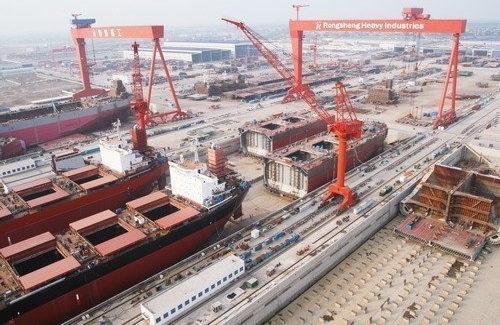
RUGAO, China/SINGAPORE (Reuters) - Deserted flats and boarded-up shops in the Yangtze river town of Changqingcun serve as a blunt reminder of the area"s reliance on China Rongsheng Heavy Industries Group, the country"s biggest private shipbuilder.A view of the Rongsheng Heavy Industries shipyard is seen in Nantong, Jiangsu province December 4, 2013. REUTERS/Aly Song
The shipbuilder this week predicted a substantial annual loss, just months after appealing to the government for financial help as it reeled from industry overcapacity and shrinking orders. Rongsheng lost an annual record 572.6 million yuan ($92 million) last year, and lost 1.3 billion yuan in the first half of this year.
While Beijing seems intent to promote a shift away from an investment-heavy model, with companies reliant on government cash injections, some analysts say Rongsheng is too big for China to let fail.
Local media reported in July that Rongsheng had laid off as many as 8,000 workers as demand slowed. Three years ago, the company had about 20,000 staff and contract employees. This week, the shipbuilder said an unspecified number of workers had been made redundant this year.
A purpose-built town near the shipyard’s main gate, with thousands of flats, supermarkets and restaurants, is largely deserted. Nine of every 10 shops are boarded up; the police station and hospital are locked.
“In this area we’re only really selling to workers from the shipyard. If they’re not here who do we sell to?” said one of the few remaining shopkeepers, surnamed Sui, playing a videogame at his work-wear store. “I know people with salaries held back and they can’t pay for things. I can’t continue if things stay the same.”
In the shadow of the shipyard gate, workers told Reuters the facility was still operating but morale was low, activity was slowing with the lack of new orders and some payments to workers had been delayed.
“Without new orders it’s hard to see how operations can continue,” said one worker wearing oil-spattered overalls and a Rongsheng hardhat, adding he was still waiting to be paid for September. He didn’t want to give his name as he feared he could lose his job.
“Morale in the office is quite low, since we don’t know what is the plan,” said a Rongsheng executive, who declined to be named as he is not authorized to speak to the media. “We have been getting orders but can’t seem to get construction loans from banks to build these projects.”
While Rongsheng has won just two orders this year, state-backed rival Shanghai Waigaoqiao Shipbuildinghas secured 50, according to shipbroker data. Singapore-listed Yangzijiang Shipbuildinghas won more than $1 billion in new orders and is moving into offshore jack-up rig construction, noted Jon Windham, head industrials analyst at Barclays in Hong Kong.
Frontline, a shipping company controlled by Norwegian business tycoon John Fredriksen, ordered two oil tankers from Rongsheng in 2010 for delivery earlier this year. It now expects to receive both of them in 2014, Frontline CEO Jens Martin Jensen told Reuters.
Greek shipowner DryShips Inchas also questioned whether other large tankers on order will be delivered. DryShips said Rongsheng is building 43 percent of the Suezmax vessels - tankers up to 200,000 deadweight tons - in the current global order book. That"s equivalent to 23 ships, according to Rongsheng data.
Speaking at a quarterly results briefing last month, DryShips Chief Financial Officer Ziad Nakhleh said Rongsheng was “a yard that, as we stated before, is facing difficulties and, as such, we believe there is a high probability they will not be delivered.” DryShips has four dry cargo vessels on order at the Chinese firm.
Rongsheng declined to comment on the Dryships order, citing client confidentiality. “For other orders on hand, our delivery plan is still ongoing,” a spokesman said.
At least two law firms in Shanghai and Singapore are acting for shipowners seeking compensation from Rongsheng for late or cancelled orders. “I’m now dealing with several cases against Rongsheng,” said Lawrence Chen, senior partner at law firm Wintell & Co in Shanghai.
Billionaire Zhang Zhirong, who founded Rongsheng in 2005 and is the shipyard"s biggest shareholder, last month announced plans to privatize Hong Kong-listed Glorious Property Holdingsin a HK$4.57 billion ($589.45 million) deal - a move analysts said could raise money to plug Rongsheng"s debts.
Meanwhile, Rongsheng’s shipyard woes have already pushed many people away from nearby centers, and others said they would have to go if things don’t pick up. Some said they hoped the local government might step in with financial support.
The Rugao government did not respond to requests for comment on whether it would lend financial or other support to Rongsheng. Annual reports show Rongsheng has received state subsidies in the past three years.

The shipyard, located in the Yangtze River Delta, was founded in 2006, and became the largest private shipbuilder in China, churning out giant valemaxes at its four large dry-docks, before a massive financial collapse forced it to cease operations in 2014.
Broking sources in China tell Splash that the yard’s former chief operating officer David Luan is now preparing to officially reopen the yard, to be known as SPS Shipyard, a reference to ShipParts.com, a business he created in 2015 after quitting Rongsheng.
SPS Shipyard will start to market cape and kamsarmax slots from next week with next available slots being from Q3 2025 onwards. Luan has yet to reply to questions sent by Splash earlier today.
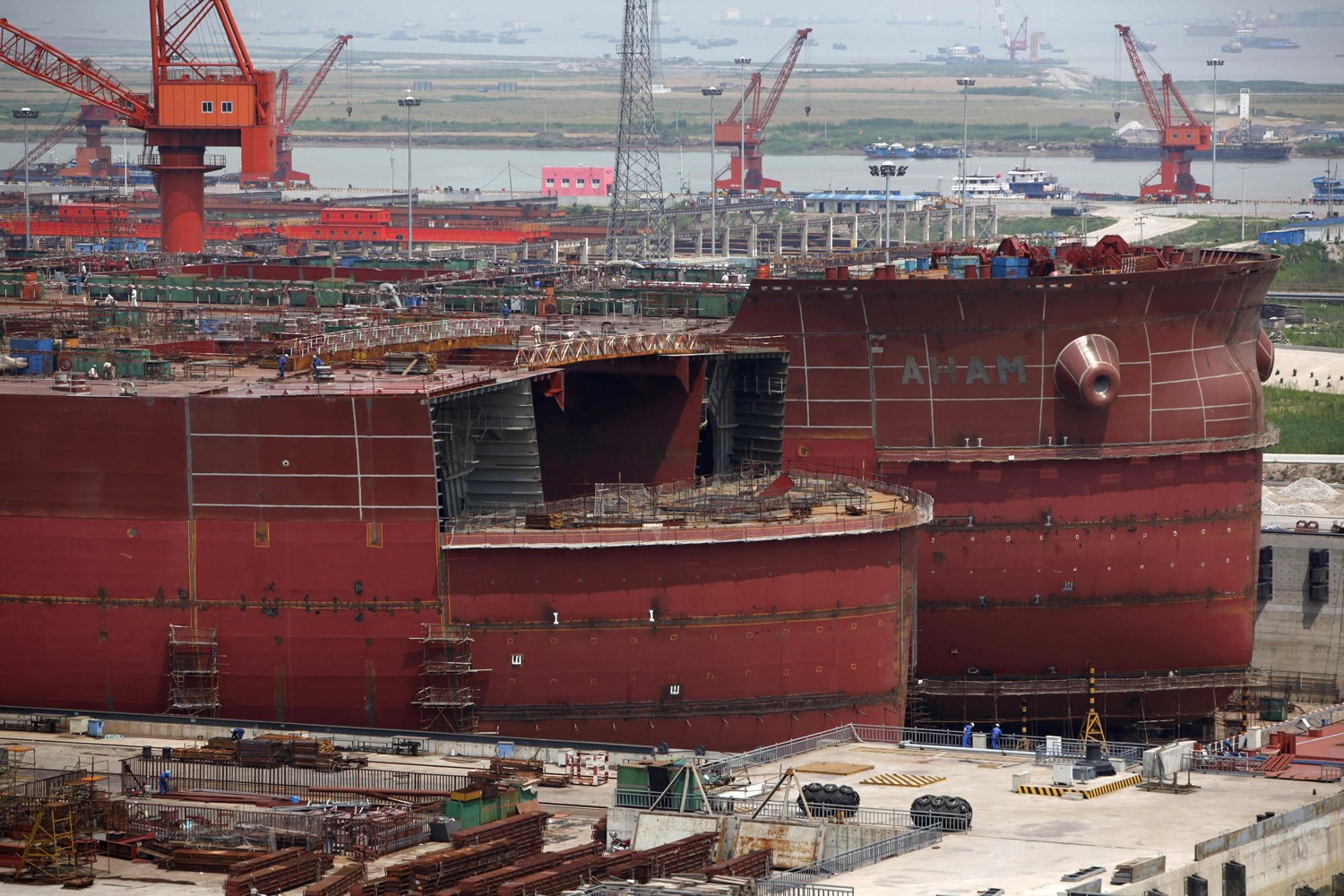
Rongsheng Heavy Industries Group Holdings Limited is pleased to announce the establishment of Rongsheng Offshore & Marine Private Limited (“Rongsheng Offshore & Marine”), the Group’s new offshore engineering base, in Singapore. The company will focus on research and development, marketing and “Engineering, Procurement and Construction” (“EPC”) projects in offshore engineering, drawing on Singapore’s superior industry advances and human resources. On the same day, Rongsheng Offshore & Marine also officially announces that it has secured an EPC contract for a 2,000-meter deepwater tender barge. With sound developments made in the high-end offshore equipment manufacturing field, the Group will seek to accelerate its all-round transformation into an offshore engineering service provider.
Rongsheng Offshore & Marine, a wholly-owned subsidiary of China Rongsheng Heavy Industries and registered in Singapore, is set to become a light asset, high technology and first class offshore engineering talent base. It will play an important role in the Group’s offshore engineering strategy; the sales team is positioned to help the Group to gain market share in the international offshore engineering market, and the operational team will help the Group to achieve greater breakthroughs by engaging in high-end operational activities such as research and development, EPC project management and international procurement.
Mr. Chen Qiang, Executive Director and Chief Executive Officer of China Rongsheng Heavy Industries, said: “The opening of Rongsheng Offshore & Marine marks an important milestone towards the Group’s goal to upgrade and transform into an offshore engineering service provider. Combined with the company’s new, innovative operating model and technological platform and Jiangsu Rongsheng Heavy Industries Company Limited’s (“Jiangsu Rongsheng”) strong manufacturing base, China Rongsheng Heavy Industries has gained access to the global market and can now make their presence felt in the high-end marine equipment manufacturing field. By improving efficiency and lowering cost through synergizing the Group’s various business areas, we are confident that we can build Rongsheng into a world-class offshore engineering brand.”
The project in question is an EPC project, covering Engineering, Procurement, Construction. Rongsheng Offshore & Marine is the general contractor, and Jiangsu Rongsheng is the manufacturer. China Rongsheng Heavy Industries is one of the few shipbuilders in China capable of undertaking an EPC project, and the winning of this tender highlights the technological and manufacturing strength of China Rongsheng Heavy Industries in the marine engineering field. It also demonstrates the recognition received by the Group in the international shipbuilding and offshore engineering industries.
Mr. Don Lee, Director and Chief Executive Officer of Rongsheng Offshore & Marine, has made great achievements in offshore engineering and commands a considerable reputation, having established extensive contacts and close cooperation with offshore rig owners and petroleum companies over the course of 40 years in the field. Prior to his appointment at Rongsheng, Mr. Lee served as an Senior General Manager at Sembcorp Marine’s subsidiary Jurong Shipyard, Senior Vice President of the Marketing of Sembcorp Marine,Director of Jurong Brazil, Director of Brazil Netherlands BV, and Director of PPL Shipyard.
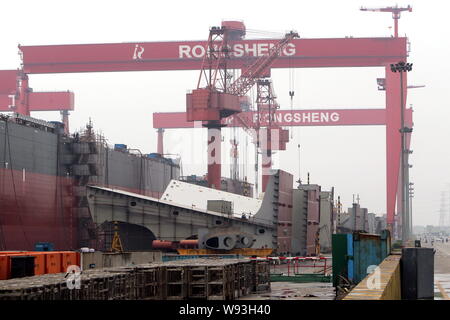
RM2CWKKB5–A labourer welds part of the structure of a ship which is under construction at the Hudong-Zhonghua Shipbuilding company"s shipyard in Shanghai October 14, 2013. China laid out a detailed three-year plan in early August to restructure its massive shipbuilding industry, urging local governments to halt approvals of new projects and companies to build high-tech vessels. While state-owned and better quality private shipyards now have enough construction orders to keep busy into 2015 or 2016, the future looks grim for the rest, many of whom have already run out of work. Picture taken October 14, 2
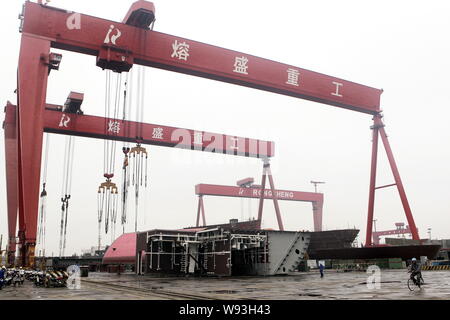
Since Beijing appears intent on telling investors it is serious about changing the investment-led growth model of the world’s second-biggest economy and controlling a credit splurge, it may seem like the writing is on the wall for China Rongsheng Heavy Industries Group.
Yet analysts say the government is more likely than not to judge that Rongsheng, which employs around 20,000 workers and has received state patronage, is too big and well connected to fail.
Supporting Rongsheng will not mean China’s economic reform plans are derailed, they say. Instead, it will mean reforms will be gradual and the government will cherry-pick firms it wants to support, which will exclude the small, private shipbuilders that have been folding in waves.
“Rongsheng is a flagship in the industry,” said Lawrence Li, an analyst with UOB Kay Hian in Shanghai. “The government will definitely provide assistance if companies like this are in trouble.”
Analysts say Rongsheng is possibly the largest casualty of a sector that has grown over the past decade into the world’s biggest shipbuilding industry by construction capacity. Amid a global shipping downturn, new orders for Chinese builders fell by half last year. In Rongsheng’s case, it won orders worth $55.6 million last year, compared with a target of $1.8 billion.
Rongsheng appealed for government aid on Friday, saying it was cutting its workforce and delaying payments to suppliers to deal with tightened cash flow.
In the prospectus for its initial public offer, Rongsheng said it received 520 million yuan of subsidies from the Rugao city government in the southern province of Jiangsu, where the company is based.
The state funds paid for research and development of new types of vessels, and were based in part on the “essential role we play in the local economy”, Rongsheng said.
As the world’s largest shipbuilder, it had 1,647 shipyards in 2012, data from China Association of the National Shipbuilding Industry showed. Over 60 percent of its shipbuilders are based in Rongsheng’s province of Jiangsu.
Despite this, the government is providing support for the industry, a sign it will also support Rongsheng given its prominence in the sector, analysts said.
Analysts say what separates Rongsheng from many other companies are its connections with the government and state banks. Rongsheng’s Chief Executive Chen Qiang, for example, enjoys “special government allowances” granted by China’s cabinet, the firm’s annual reports say.
Rongsheng also said in its IPO prospectus that it has two five-year financing deals with Export-Import Bank of China that end in 2014 and in 2015, and a 10-year agreement with Bank of China starting from 2009.
After all, local government coffers will suffer the biggest blow if Rongsheng goes bust. The firm had 168 million yuan of deferred income taxes in 2012.
“Do people expect one of the largest shipyards in the world is going to stop building ships completely with state-of-the-art, brand new facilities?” said Martin Rowe, managing director of global shipping services provider Clarkson Asia Ltd. “I think it’s highly unlikely.” (Reporting by Yimou Lee in HONG KONG and Koh Gui Qing in BEIJING; Editing by Neil Fullick)
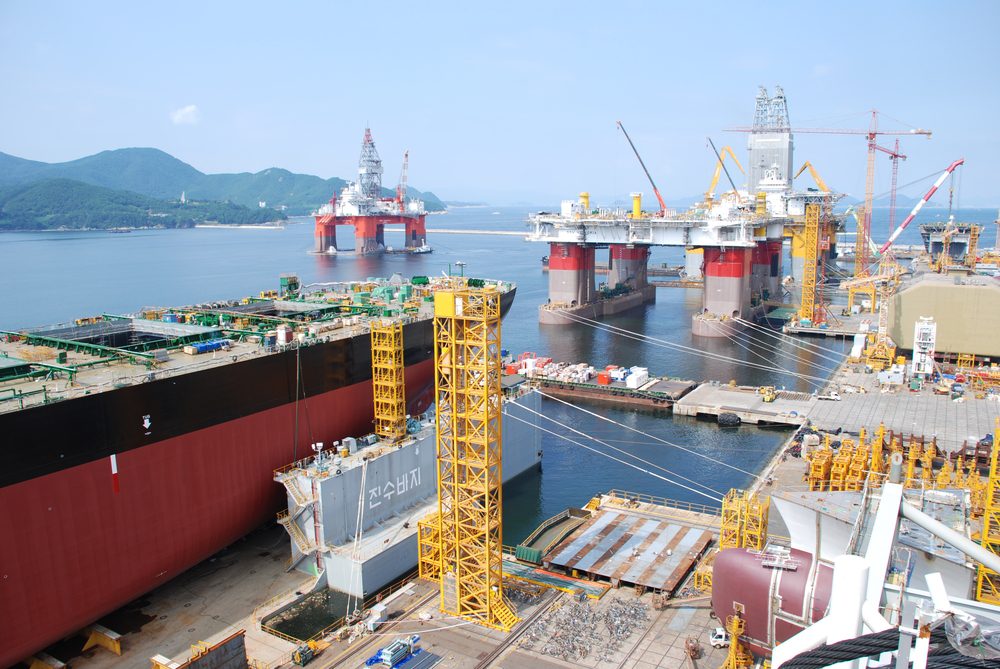
Another once-leading privately-owned yard China Huarong Energy Company, previously and better known as China Rongsheng Heavy Industries, continues to struggle with debts and ongoing talks with its creditors. The shipbuilder with huge yard facilities is now literally a �ghost yard�, where operations have ceased as funds dried up.
Jiangsu Rongsheng Heavy Industries Group Co. used to employ more than 30,000 people in the eastern city of Rugao. Once China�s largest shipbuilder, by 2015 Rongsheng was on the verge of bankruptcy. Orders had dried up and banks are refusing credit. Questions have been raised about the shipyard�s business practices, including allegations of padded order books. And Rongsheng was apparently behind on repaying some of the 20.4 billion yuan in combined debt owed to 14 banks, three trusts and three leasing firms.
Rongsheng is on the ropes now that it had completed a multi-year order for so-called Valemax ships for the Brazilian iron ore mining giant Companhia Vale do Rio Doce. The last of these 16 bulk carriers, the Ore Ningbo, was delivered in January 2015. With a carrying capacity of up to 400,000 tons, Valemaxes are the world�s largest ore carriers. Vale hired Rongsheng to build the ships starting in 2008, and has tolerated the shipyard�s slow pace: The Ore Ningbo was delivered three years late. Rongsheng employees said the Ore Ningbo may have been the shipyard�s last product because no new ship orders are expected and all contracts for unfinished ships have either been canceled or are in jeopardy.
Founder and former chairman Zhang Zhirong started the company in 2005 with money made when he worked as a property developer in the 1990s. The new shipyard stunned the industry by clinching major vessel orders from the start, even at a time when most of the world�s shipyards were slumping. Rongsheng�s success attracted investors and banks to the company�s side, fueling its expansion.
The shipyard, a sprawling facility spread across one-third of Changqingsha Island in the middle of the Yangtze River, suffered from a lack of capacity and management problems. As a result, the company had trouble meeting its contract obligations, including delivery timetables. Rongsheng�s problems were tied to difficulties with delivering ships. Many of Rongsheng�s order cancellations were due to its own delivery delays.
After the global financial crisis of 2008, many ship owners could no longer afford paying in advance for new vessels. So builders such as Rongsheng started arranging up-front financing with Chinese banks that got projects off the ground.
Rongsheng built ships with a combined capacity of 8 million tons in 2010 and was preparing to begin filling US$ 3 billion in new orders the following year. But the company�s 2011 orders wound up totaling only US$ 1.8 billion. That same year, Rongsheng�s customers canceled contracts for 23 new vessels.
In 2012, Rongsheng received orders for only two ships. Layoffs ensued, with some 20,000 workers getting the axe. The company closed the year with a net loss of 573 million yuan, down from a 1.7 billion yuan net profit in 2011 and despite 1.27 billion yuan in government subsidies. The bleeding worsened in 2013, with 8.7 billion yuan in reported losses. Despite a recovery of the Chinese shipbuilding industry in 2014, Rongsheng saw no relief, as its clients canceled orders for 59 vessels that year.
Roxen Shipping, a company controlled by Chinese businessman Guan Xiong, reportedly stepped in to rescue some US$ 2 billion worth of ship contracts that were canceled by Rongsheng�s other customers. Without these orders, Rongsheng never would have maintained its status as the No. 1 shipbuilder in China from 2009 to 2013.
Rongsheng�s capital crunch worsened since February 2014, when the China Development Bank (CDB) demanded more collateral after the company failed to make a scheduled payment on a 710 million yuan loan. When Rongsheng refused, the CDB called the loan. Other banks that issued loans to the shipbuilder had taken similar steps.
Rongsheng�s weak financial position was highlighted by a third-quarter 2014 financial report in which the company posted a net loss of 2.4 billion yuan. It also reported 31.3 billion yuan in liabilities, including 7.6 billion yuan worth of outstanding short-term debt.
It would cost at least 5 billion yuan to restart operations at Rongsheng�s facility, plus they have a huge amount of debt. Buying Rongsheng would not be a good deal.
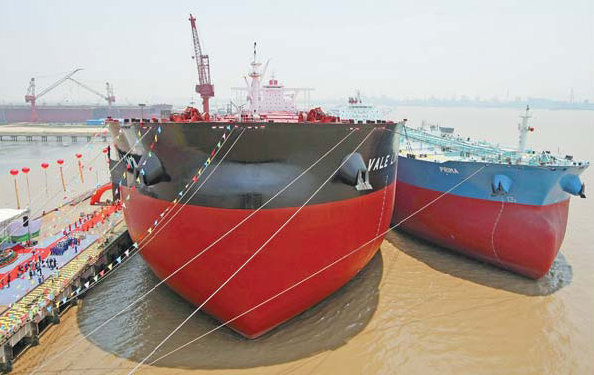
W�rtsil� and Jiangsu Rongsheng Heavy Industries Group Co Ltd (RSHI) have jointly signed a licence agreement for the manufacture and sale of W�rtsil� low-speed marine diesel engines by RSHI in China.
�The licence agreement with W�rtsil� is an important milestone for the expansion of RSHI into the marine equipment business. This agreement will enable RSHI to produce today�s most advanced low-speed diesel engines for its own shipyard as well as for external customers, securing RSHI�s future leading role in the Chinese ship and engine building industries�, said Mr Chen Qiang, President and Vice Chairman of the Board of RSHI.
�RSHI is one of the most rapidly expanding shipyard conglomerates in China. It is a pleasure to work with RSHI on the new engine factory, which will fully start with the production of W�rtsil� common-rail low-speed engines. We look forward to a long-lasting fruitful partnership,� said Mr Martin Wernli, President of W�rtsil� in Switzerland.
The investment in the new engine factory in Hefei requires an approval from the NDRC (National Development and Reformation Committee of the People"s Republic of China) which is currently in progress. The factory will primarily serve the new shipyard of RSHI which is being developed on Changqingsha Island in Rugao City near Nantong, China. The shipyard covers an area of about four square kilometres with a 3.7 kilometre water frontage. Equipped with two large, building drydocks, the yard is being set up to build a wide variety of ship types, including bulk carriers of panamax size and larger, tankers from Aframax to VLCC sizes, LPG and LNG carriers, and containerships from 4250 TEU to 9700 TEU. RSHI plans to deliver some forty vessels a year, totalling about five million tonnes deadweight.
Next to the shipyard, RSHI is also establishing an offshore yard covering an area of about 1.7 square kilometres with one large, building drydock for constructing FPSO (floating production, storage and offloading) vessels and other offshore projects.
W�rtsil� enhances the business of its customers by providing them with complete lifecycle power solutions. When creating better and environmentally compatible technologies, W�rtsil� focuses on the marine and energy markets with products and solutions as well as services. Through innovative products and services, W�rtsil� sets out to be the most valued business partner of all its customers. This is achieved by the dedication of more than 16,000 professionals manning 150 W�rtsil� locations in 70 countries around the world. W�rtsil� is listed on The Nordic Exchange in Helsinki, Finland.
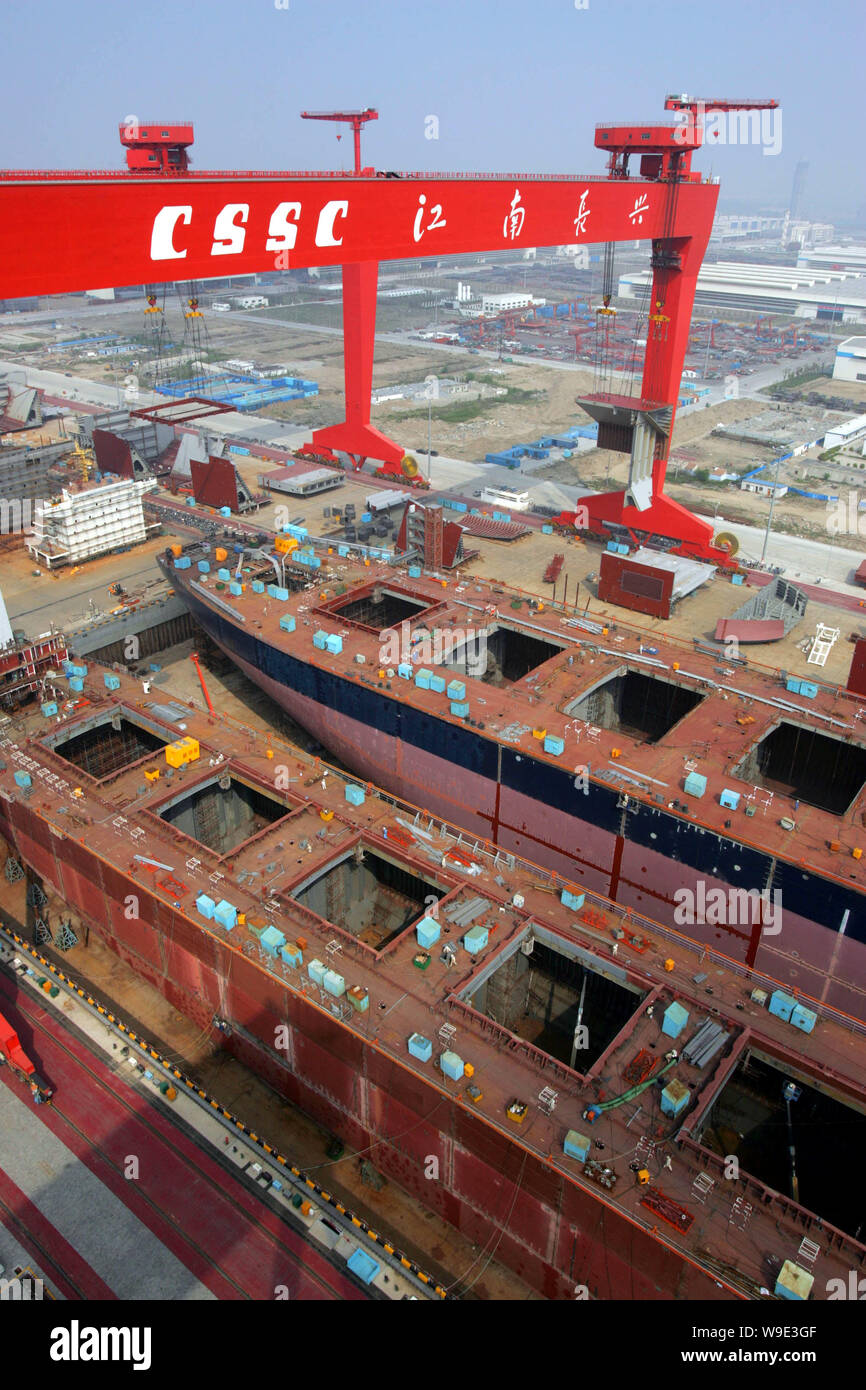
Wärtsilä"s two-stroke engines have been chosen for eight Chinese bulk carriers. The order was placed by Beijing-based Minsheng Financial Leasing Co. Ltd. Wärtsilä"s Chinese licensee, Hefei Rong"An Power Machinery Co Ltd (Rong"An), a member of the Jiangsu Rongsheng Heavy Industries Group Co Ltd (RSHI), will build the engines. The Wärtsilä RT-flex58TB two-stroke engines will be installed in a series of eight 76,000 dwt Panamax bulk carriers. The first vessel is scheduled to be launched in March 2011.
The bulk carriers will be built in Nantong, China by Rongsheng Shipbuilding & Heavy Industries, part of the Jiangsu Rongsheng Heavy Industries Group Co Ltd (RSHI). RSHI is a large and highly integrated heavy industries group whose business covers shipbuilding, ship repairing, steel structures, and engine manufacturing. The company runs China"s third-largest shipyard and is the country"s largest private shipbuilding group; its order book currently consists of 83 vessels. Equipped with two large dry docks, RSHI is able to build a wide variety of vessel types, including bulk carriers of Panamax size and larger, tankers from Aframax to VLCC sizes, LPG and LNG carriers, and containerships of 4250-9700 TEU.




 8613371530291
8613371530291